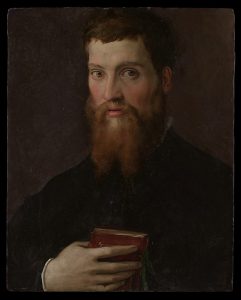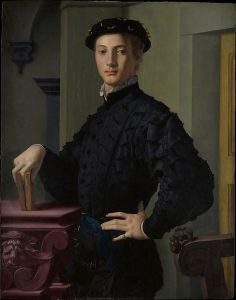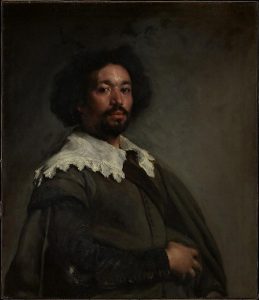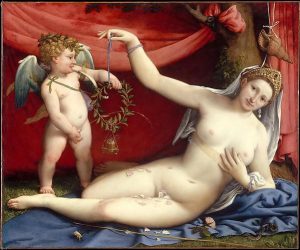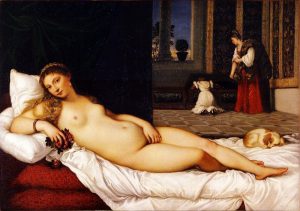EASEL ESSAY: Not just for “nerds”: vivid stories from the Old Masters

Why do we still pay attention to Old Masters paintings? There are a handful of famous names – Rembrandt, Vermeer, Velázquez, Michelangelo – toward whom adulation seems obligatory. Yet, walking the galleries of a major museum, you quickly realize there are many others. With their ornate gilded frames and often perplexing subjects, why should their works command modern attention? Indeed, why do museums continue to acquire them?
Keith Christiansen, a self-confessed addict of paintings by the Old Masters, is the John Pope-Hennessy Chairman of the Department of European Paintings at New York’s Metropolitan Museum. Recently Morgan Meis, Contributing Editor of The Easel, talked to Keith about the modern relevance of these works. Keith suggested framing the discussion around three (or is it four?) main works, all from the Met’s collection.
Morgan Meis Keith, lets dive straight into the three works that you have nominated – Francesco Salviati, Diego Velázquez and Lorenzo Lotto. Starting first with Francesco Salviati. I am not so familiar with this artist or with the particular work you have suggested. Looking at the image, I can see there is skill, but am not sure what I am supposed to find beyond that.
Francesco Salviati (Francesco de’ Rossi, 1510–1563) Carlo Rimbotti (1518-1591) Oil on wood. Purchase, Walter and Leonore Annenberg Acquisitions Endowment Fund, Alejandro Santo Domingo, Ronald S. Lauder, and The Morris and Alma Schapiro Fund Gifts, and Beatrice Stern, Annette de la Renta, Brownstein Family Foundation, and David and Julia Tobey Gifts, 2017
Keith Christiansen I fell in love with Old Master paintings during my junior year abroad in college and the travels in Europe that I took the following summer. Being a nerd, I spent most of my time in museums, and discovered that I fell in love with the works by artists I knew little or nothing about. You could say that I have been trying to make up for that ignorance ever since. What I have learned over my career is that these works tell stories, vivid stories that often seem to me to speak to our modern times.
So let’s begin with the portrait by Salviati. At the risk of upsetting your plans, I would like to approach it by introducing another painting by an artist who today enjoys more fame: Bronzino. And the reason I want to do this is because the Bronzino played a role in the Met acquiring the Salviati and it provides a context for appreciating what is so singular about Salviati’s work.
At the Metropolitain Museum we have one of the great portraits by Bronzino, who was court painter for the Medici in Florence in the mid-16th century. I suppose that most people looking at this work would characterize the sitter as arrogant. I mean, look at his proud posture, with one arm akimbo, his aloof gaze, and the way the fingers of his right hand commandingly mark a place in the book that he is using as a kind of prop. Look at his handsome but impassive expression and then note the grotesque, grimacing veiled mask decoration of the table and the grotesque horned head on the chair. If you look closely you’ll see that even the fabric around his codpiece forms a kind of grotesque mask. Indeed, the whole picture seems to be about masks. Their bestial aspect contrasts with the sitter’s refinement. But they also make me think, more generally, about issues of identity and self-presentation. We happen to know that Bronzino wrote poetry—sometimes pretty scurrilous—and the sitter of this portrait probably belonged to his tight group of highly literate friends. This is a picture filled with conceits addressed to an elite circle.
Bronzino (Agnolo di Cosimo di Mariano,1503–1572) Portrait of a Young Man 1530’s oil on wood H. O. Havemeyer Collection, Bequest of Mrs. H. O. Havemeyer
Now, have a look at the Salviati. First, there is obvious skill, as you have mentioned. There is no elaborate architectural setting, no accoutrements beyond the book he holds. And no attitude. Instead, the sitter is shown with his head turned slightly but gazing at us with disarming directness. The moles on his brow and forehead are details that dismantle the polished, conceitful world of Bronzino’s portrait and we feel, by contrast, as though we are in the presence of a real person. He may belong to a world that is different to the one that we inhabit, but that is not what I feel standing in front of it.
This picture took my breath away when I was shown it in London precisely because of this quality of a real encounter. I could not help but think what a marvelous counterpoint it would make with the Bronzino—how, together, the two could tell so much more about Renaissance Florence than either by itself. The one would illuminate the other. In Bronzino’s portrait artifice is intentionally employed not only to construct an identity, but to create a distance from the viewer. The opposite is the case with Salviati’s portrait, in which conspicuous artifice has been torn away in order to suggest direct contact with somebody. This is the reason I wanted the picture.
Hanging as it does in the gallery next to the Bronzino, the Salviati puts into play the function of artifice. And, in the end, doesn’t this resonate with what we observe every day: those people who strike us as constructed personalities, and those with whom we feel a genuine connection? It is a reminder of the power of societal conventions that shape behavior and the way that some people seem to escape from them.
Morgan Meis So you’re saying that the fact that this is a portrait of a person that actually lived, who is wearing the dress of his times, seems to give us a concrete glimpse of a real human being?
Keith Christiansen Both sitters actually lived. But while one reminds us of the distance separating us from the Renaissance, the other suggests a surprising familiarity. Salviati’s portrait is like an invitation to dive in, to discover both connections and differences. That’s what makes life interesting. I suppose that one of the periods of the past that many younger people are aware of is the Renaissance. There are certain icons – da Vinci, Michelangelo, Raphael, possibly Titian. As you explore the period more deeply, you begin to see that, in addition to the mythological paintings – such as the one by Lorenzo Lotto that we will discuss shortly (a very strange picture at first glance) – there are portraits of people from the past that speak in a way that seems disarmingly familiar.
Morgan Meis Fascinating. Let’s move on now to the Velazquez you have chosen.
Velázquez (Diego Rodríguez de Silva y Velázquez, 1599–1660) Juan de Pareja, 1650 oil on canvas Purchase, Fletcher and Rogers Funds, and Bequest of Miss Adelaide Milton de Groot (1876–1967)
Keith Christiansen Another portrait, this one from the seventeenth century; a picture that enjoys enormous fame. Famous artist, famous picture – not least because when it was acquired by the museum in 1971, it set a world record price. Like El Greco’s View of Toledo, it’s one of the pictures people set out to see when they walk through the doors of the museum, if they are interested in European painting.
But this is a picture that has an added dimension. Let’s go see it. The subject is Velázquez’s slave, Juan de Pareja! His mother was a Muslim, his father a Spaniard, so he was of mixed race. We do not know how Velázquez got him. We assume he inherited him but we don’t hear much about him until 1649, when Velázquez was in Italy. He left his son-in-law in Madrid to run the workshop but took Juan de Pareja who, by this time, must have functioned as a kind of assistant – but we don’t know.
What is going on? The king’s artist goes to Italy on a buying trip – to buy pictures for the royal collection – and is about to get a commission to paint the Pope’s portrait. He decides to show his talent at the annual art fair outside the Pantheon by painting a portrait of his slave! And not just that, he paints him in a pose that suggests extraordinary pride, bordering, some might say, on arrogance!
Morgan Meis Would he have been dressed that way in daily life?
Keith Christiansen I think so. He’s not in fancy dress, he’s dressed like someone from the mercantile class.
Morgan Meis So it’s not a fantasy picture. Velázquez is trying to give his slave a sense of the dignity that he had in day to day life?
Keith Christiansen You know, the thing that’s so interesting about this picture is that the response to that question today is different from what it would have been twenty years ago. And that is because we continuously ask new questions about the past. I re-wrote the online entry for this picture when I saw that there has emerged an extensive literature on the history of Africans in European art. There is now also an excellent book about slaves in Spanish painting, and Juan de Pareja, of course, figures prominently in that book because he became a painter of some success – independently, after he was given his freedom by Velazquez.
MM Have any of his paintings survived?
KC Yes! In fact, his greatest painting is in the Prado, hanging in a gallery near those by Velázquez. He was a painter of considerable talent and created an independent career. At the same time Velázquez painted his portrait, he signed a legal document that granted de Pareja his freedom within four years. This suggests a very interesting relationship between what we would call master and slave.
MM Would you call this political art – a protest painting of the time?
KC Well, we don’t hear of any response to the picture beyond admiration. But there are more questions than answers right now. We are beginning to learn more about servitude in the past, in particular about the lives of people like de Pareja, a mulatto, in servitude to an artist. Here’s what I would say: when trying to understand the past, you are always working with hypothetical reconstructions based on existing evidence and looking for confirmation—or not—of those reconstructions. Two different readings have been proposed. One would have it that by publicly displaying a portrait of his slave, Velázquez was advertising his own status as a slave owner. I’m not so convinced by that view. The other interpretation, which I find more persuasive, would have it that Velázquez was giving demonstration to the way his art could transform a slave into a person of commanding personality and presence. In effect, the picture is an advertisement of the ability of his art to transform anybody into an extraordinary person – which set him up for his next task with Pope Innocent X. This is a really interesting idea; the power of art to reconstruct personalities—another iteration on what we discussed in the case of Bronzino and Salviati.
MM But something in me wants to feel that he is not just transforming a lowly slave but also bringing out the inherent dignity of the person.
KC Perhaps, but don’t you think we all like to think that a great artist is also a great human being with enormous capacity to recognize the dignity of all people? I wish we knew more about Juan de Pareja as a person. His painting in the Prado – the one I mentioned earlier – includes a self-portrait. And the impression it creates is of a person who seems quite different to the one portrayed by Velázquez. You may be right, and Velázquez may be showing us a quality he saw in de Pareja and he may even be promoting de Pareja’s ambition to be an independent artist. It’s interesting that even after he was freed, de Pareja stayed on as Velázquez’s assistant. These paintings from the past carry mysteries with them! You look at a picture, you ask a question and it’s like opening a book without a concluding chapter. We are obliged to confess that much of what we think we know is actually conjecture or a reconstruction. So much of what we are learning about black history comes from wanting to get beyond the surface image and received opinion.
MM One more question about this painting. If you look at the background it almost looks like it could be part of a JMW Turner seascape, it looks like an abstract painting to some degree and one that’s almost intentional in its marks, swirls of colours and brushstrokes. Am I crazy to see that?
KC It’s just a neutral background (much laughter).
MM So why not the background plain – there’s so much paintwork going on in that background?
KC Well, this painting is in miraculous condition, but the paint was not laid on with equal thickness and with time the thinner areas have gone somewhat transparent. Also, Velázquez wanted the background to have a certain amount of movement and not to read as flat. The dappled look you are picking up has increased with age.
MM Okay, I get it, I’ll stop over-reading!
Let’s move on to the Lotto, Venus and Cupid, from around the 1520’s. When you look at it, it’s a very strange scene with Cupid seeming to pee on Venus. What in the world is going on in this painting?
Lorenzo Lotto Venus and Cupid (Venice ca. 1480–1556) oil on canvas Purchase, Mrs. Charles Wrightsman Gift, in honor of Marietta Tree
KC This painting has such a great story. When it was offered to the Met (it was previously known only via a photograph and a line engraving) I was given the task of finding out as much as I could because it is unlike any other Venus and Cupid that has come down to us from the Renaissance. We have many paintings depicting Venus and Cupid, but the emblems in the picture—the myrtle wreath, the incense burner, the shell–and Cupid’s action are unique. What on earth was this Cupid doing? As best as I could find out, Cupid peeing is an emblem of fertility. He is not just peeing through a wreath onto his mother, he’s peeing onto her private parts! And he’s doing it with a grin on his face! She’s holding the wreath and she, too, has a smile on her face –
MM She’s complicit in all this!
KC Yes, and she is looking out at the viewer! Hanging from the wreath is an incense burner. Another mystery! It sent me to reading about classical marriage poetry—epithalamia—which is to say, classical and Renaissance poetry that was composed on the occasion of a marriage. In these poems, Venus is summoned from her bower to come and bless the marriage – that’s what’s going on here. Most provocative is the shell that hangs above Venus’s head. It’s so obvious that I don’t think there’s any question that we are looking at something meant to suggest Venus’s sexual organ.
MM Yes, that seems pretty clear. So, it’s a fertility scene?
KC It’s a fertility painting! And I was struck by the face of Venus – it doesn’t look idealized but rather has the appearance of a real person. In looking at what contemporaries wrote about these pictures, they openly embraced the erotic element in them. Indeed, it was explicitly said that these were pictures suited for the bedroom, because they would arouse the male. They therefore were invitations to fecundity. So this is probably a bedroom picture, celebrating a marriage, and it’s even possible that Venus’s face is the face of the bride. She wears a crown, a veil and just one earring, and we know that these were part of the normal garb of a bride in 16th century Venice. That’s pretty cool, I think!
MM That’s interesting. Lotto, apart from this work, was doing a fair amount of religious and church painting. Is there a contradiction between this openly pagan, sexual, erotic painting on the one hand and the religious – are those things allowed to exist together in this world?
KC Your last sentence is exactly where I would go. We have created separate strands out of what was, in the Renaissance, a culture that saw no necessary contradiction between embracing both erotic and the sacred. After all, procreation was seen as the primary reason for marriage in the first place.
MM You are suggesting there was a pagan sensibility in the bedroom and a Christian one on Sunday!
KC Not really, because religious paintings also had their place in the bedroom, and we find pagan motifs in churches. This is such an interesting area. Going back to the Lotto painting, there is a viper underneath the cloth she is lying on. I think this is the most perplexing of the various emblems. There is a rod, there are white rose petals and pink rose petals. The myth about the pink rose petals was that when Cupid misbehaved and made people fall in love who should not fall in love, his mother spanked him, thus drawing blood and staining the white rose petals red. But the viper must be either an emblem of jealousy or perhaps a reminder of the dangers of mismatches. That’s the working hypothesis!
I have watched people come up to this picture, stop dead in their tracks and stare at it. I even saw one mother turn the face of her child away from it! Afraid the child might get ideas, I guess. If you have something from the 16th century that provokes wonder and questioning, I think that’s a pretty neat thing!
MM I am with you on that.
KC Your original question was ‘why do we still collect Old Master paintings’, why are we still interested in these pictures from an increasingly receding past. Well, these works remind us that the world is more complex than we give it credit for. People of the past were incredibly fascinating, dealing with some of the same issues we confront today—most signally, life’s meaning and mortality—but they did it in a different fashion, and sometimes in a way we don’t understand and possibly don’t approve of. The fact that we don’t approve of those ways should make us question our own beliefs.
MM You mentioned the way that Venus gazes directly at us; it reminds me a bit of Titian’s Venus of Urbino – and then forward to Manet’s Olympia and on from there: I am wondering – is it going too far to wonder if there is a nascent feminism in the frankness of the gaze?
KC Hm-m-m. Titian’s paintings of Venus have been much discussed. Were they, for example, intended to be perceived as prostitutes—available women, such as with Manet’s Olympia? Titian’s most famous one is known as the Venus of Urbino, because it was painted for the Duke of Urbino. In his correspondence, the Duke does not refer to her as Venus but as “quella donna nuda”, that naked lady. It reminds us that mythology provided a protective lens for what is often now referred to as the male—not the female—gaze. So, we might perhaps rephrase your question as: is her gaze frank or solicitous?
Titian (Tiziano Vecelli 1488/90 – 1576), Venus of Urbino 1538 Uffizi Gallery oil on canvas
Philip II, who was one of Titian’s greatest patrons, created a private room for himself. It had mythological paintings in it, which had a common denominator – naked women. In Titian’s correspondence with Philip II, we gain an insight into the sensual pleasures this room provided. After having painted a picture showing the nude Danaë on a bed, Titian then sent a picture of Venus and Adonis, and he wrote, in effect, that since in the last picture he showed the female figure from the front, in this picture he was showing her from the back side so that Philip could enjoy both views. How about that! I think the inherent sexuality and sensuality of these pictures is something extraordinary, but in the Lorenzo Lotto the combination of the particularized features of Venus and her gaze suggests that this is an intensely private picture – her gaze is for the bridegroom.
When does the female gaze begin to factor in? Are there nude males intended for female viewing? I think you have asked a question that runs right up against societal strictures that were pervasive until very recently. For example, Artemisia Gentileschi, perhaps the most famous female old master painter, made many paintings of women as victims—Susanna, Lucretia, etc.—as well as of heroic females, such as Judith and Esther. But no nude males. What we can’t say is what the response of women was to an altarpiece showing nude or near nude male figures—for example, Saint Sebastian shot with arrows. But it was certainly a concern of churchmen! So there was certainly the potential of a female as well as gay gaze.
MM That makes for a different walk through the galleries!
KC It does make for a different walk through the galleries! What we can say is that following the Reformation the Catholic Church decided it was necessary to pay closer attention to the potential of nudes to incite erotic desire. Society became considerably more puritanical. Nudity was out, most famously in the Sistine Chapel, where one of Michelangelo’s followers was hired to put britches on the nude figures in the Last Judgement. There were also altar pieces that were now deemed to be indecorous because they had too many nudes. Fig leaves start appearing.
MM: That’s fascinating Keith and makes me want to have a longer discussion with you about the art of the Counter Reformation; puritanical on the one hand, but so full of life and emotion on the other… no Caravaggio without the Counter-Reformation, for instance. But that will have to wait for another occasion. Thanks so much for your time and your genuine passion for these paintings.
KC You are most welcome.

